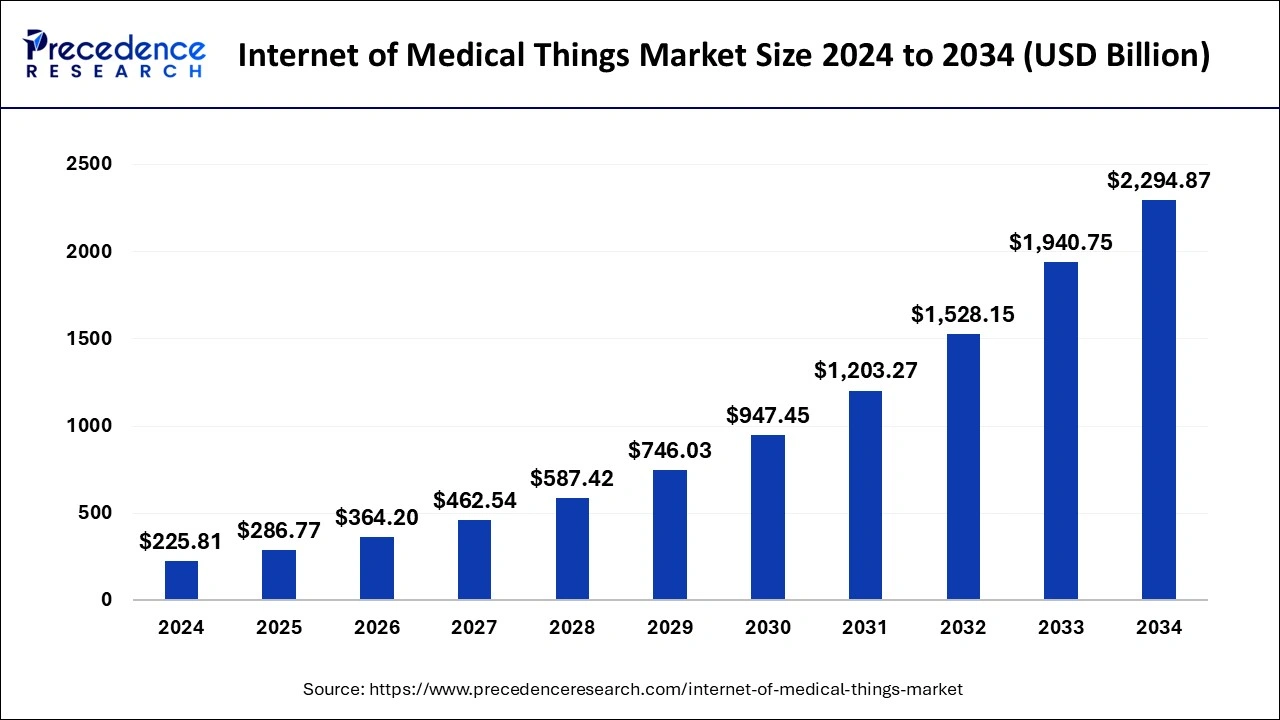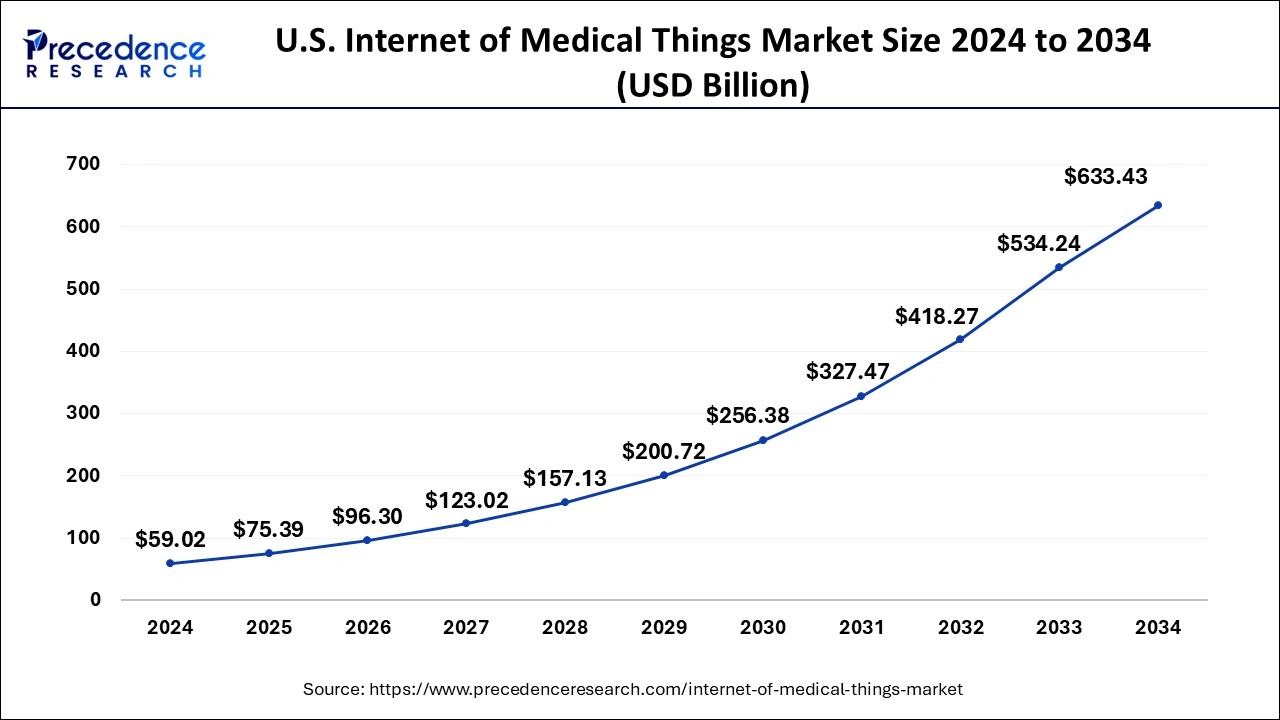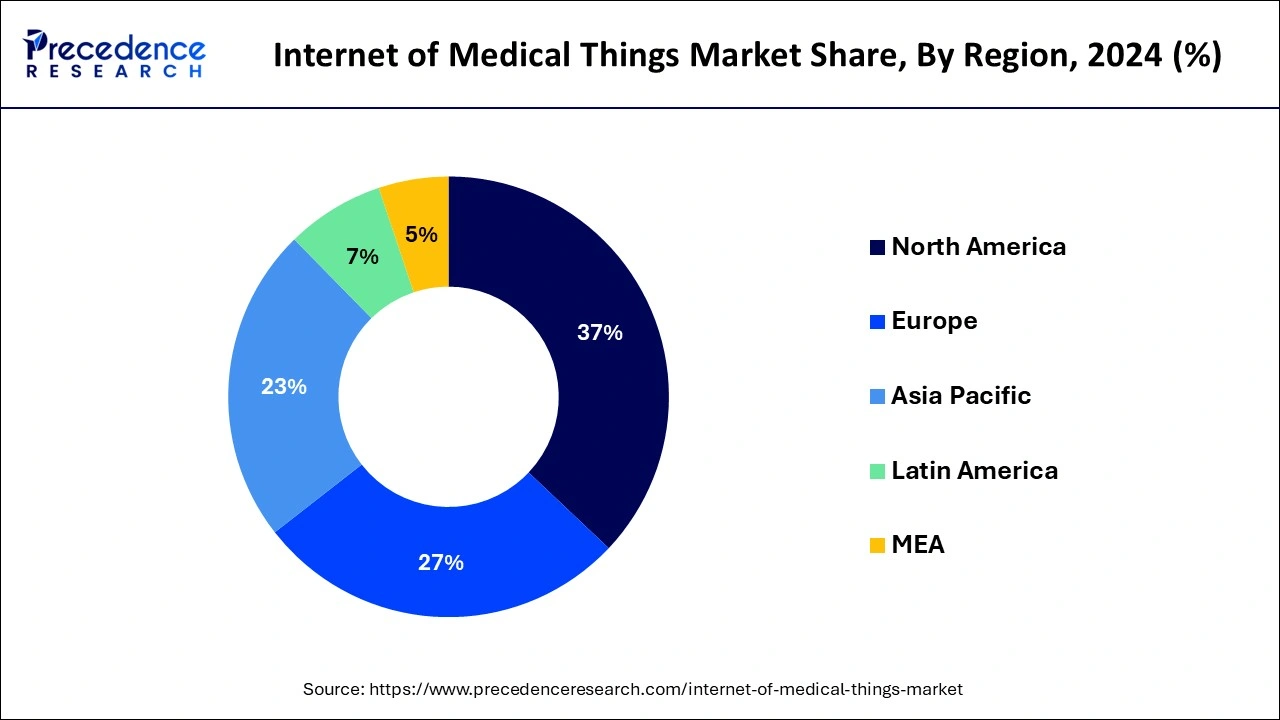December 2024
The global internet of medical things market size is calculated at USD 286.77 billion in 2025 and is forecasted to reach around USD 2,294.87 billion by 2034, accelerating at a CAGR of 26.09% from 2025 to 2034. The North America market size surpassed USD 2.34 billion in 2024 and is expanding at a CAGR of 9.11% during the forecast period. The market sizing and forecasts are revenue-based (USD Million/Billion), with 2024 as the base year.
The global internet of medical things (IoMT) market accounted for USD 225.81 billion in 2024 and is expected to exceed around USD 2,294.87 billion by 2034, growing at a CAGR of 26.09% from 2025 to 2034.

The U.S. internet of medical things (IoMT) market size size was exhibited at USD 1.64 billion in 2024 and is projected to be worth around USD 3.97 billion by 2034, growing at a CAGR of 9.24% from 2025 to 2034.

Based on region, North America dominated the global internet of medical things market in 2024, in terms of revenue and is estimated to sustain its dominance during the forecast period. North America is characterized by the strong and developed healthcare infrastructure, improved IT infrastructure, developed telecommunications, and increased penetration of internet. Further, rising consumer expenditure on health care, increased disposable income, and rising prevalence of diseases are the certain factors that has boosted the market growth in this region.

On the other hand, Asia Pacific is estimated to be the fastest-growing market during the forecast period. This is attributable to the rising disposable income of the consumers, rising health consciousness, rising government initiatives to develop IT infrastructure, and increased investments on digitalizing healthcare sector are the major drivers of the Asia Pacific internet of medical things market.
The increased adoption of the information technology in the healthcare sector and rapid technological developments in it have significantly boosted the growth of the global internet of medical thigs market. The internet of medical things helps to connect various medical devices to each other through internet connectivity. The surging popularity of 5G technology and rising investments in the development of sophisticated 5G networks across the globe is expected to drive the growth and adoption of the internet of medical thing across the healthcare units and households. The most effective feature of the IoMT is that it transfers and shares data related to the health of the patient without any human to machine interaction. The various IoMT devices like smart wearables have emerged as an effective technology that facilitates remote monitoring and diagnosis of the patients’ health. All these factors are expected to drive the demand for the internet of medical things among the various end users all over the globe.
Furthermore, the rising developmental strategies adopted by the key market players are anticipated to open new growth avenues and provide lucrative opportunities in the upcoming future. For instance, CONNEQT and LifeQ entered into a partnership in June 2021, for providing health related information to the wearable device users. Further, the recent outbreak of the COVID-19 pandemic has acted as a catalyst to the adoption of the digital technologies across all the industries including healthcare industry. The pandemic led the digital transformation in the healthcare industry at a rapid rate and this is expected to have a very long-term effect that may change the face of the entire healthcare industry in the upcoming future. Further, the increased government efforts and private investments are propelling the adoption rate of digital technologies in the healthcare sector to tackle the pandemic situation in the future. All these factors are expected boost the growth of the global internet of medical things market.
| Report Coverage | Details |
| Market Size in 2025 | USD 286.77 Billion |
| Market Size by 2034 | USD 2,294.87 Billion |
| Market Growth Rate from 2025 to 2034 | CAGR of 26.09% |
| Largest Market | North America |
| Fastest Growing Market | Asia Pacific |
| Base Year | 2024 |
| Forecast Period | 2025 to 2034 |
| Segments Covered | By Product Type, By End User, and By Application |
| Regions Covered | North America, Europe, Asia-Pacific, Latin America, and Middle East & Africa |
Based on product type, the smart wearable segment accounted for more than 25% of the market share in 2024 and is estimated to sustain its dominance during the forecast period. Smart wearable devices includes bands, activity trackers, smart garments, and sports watch. All these digital and medical devices are gaining rapid traction among the consumers owing to the rising health consciousness and rising consumer expenditure of health and wellness products. Furthermore, the development of clinical grade wearables is getting rapid traction. For instance, Neurometrix developed a neuromodulation wearable device named Quell, which provides relief from various chronic pains by tapping into the sensory nerves. Therefore, these technologically advanced product developments are expected to drive the growth of this segment further.
The point of care kits segment is expected to be the most opportunistic segment during the forecast period. This owing to the rising hospital admissions and rising number of patients visits to the clinics and hospitals.According to the CDC, in 2019, there were 45 million outpatient surgeries, over 900 million physician visits, and 155 million emergency department visits in US. Hence, the rising use of point of care kits is boosting the growth of this segment.
Based on end user, the hospitals & clinics segment dominated the global internet of medical things market in 2024, in terms of revenue and is anticipated to sustain its dominance during the forecast period. This can be attributed to the rising prevalence of chronic diseases, growing geriatric population, and rising healthcare expenditure among the consumers. The growing need for regular health check -ups and increasing demand for the smart technologies for tracking patients’ health conditions in the hospitals and clinics has boosted the growth of this segment in the past few years.
On the other hand, the homecare segment is expected to be the fastest growing segment during the forecast period. This can be attributed to the increased preferences on the consumers in the developed nation to get treatment for various diseases at their homes. Increased disposable income, increased awareness regarding hospital acquired infections, and increased consumer expenditure of health and wellness products and services are the various factors that may foster the growth of this segment during the forecast period.
Based on application, the telemedicine segment accounted largest revenue share in 2024 and is estimated to sustain its dominance during the forecast period. This can be attributed to the rapid growth and development of the telemedicine industry across the globe. The telemedicine emerged as a result of the technological advancements in the digital technology field and has been increasingly adopted across the various healthcare units around the globe. The real-time data sharing and effective communication owing to the use of telemedicine is changing the face of the healthcare industry by improving the efficiency of the healthcare sector in patient care.
On the other hand, patient monitoring segment is expected to be the fastest-growing segment owing to the rising prevalence of diseases among the population and growing geriatric population. The need for monitoring cancer patients and old age people is continuously rising and so is the adoption of the patient monitoring system. Hence, this segment is estimated to grow rapidly in the upcoming years.
Key Companies & Market Share Insights
The market is moderately fragmented with the presence of several local companies. These market players are striving to gain higher market share by adopting strategies, such as investments, partnerships, and acquisitions & mergers. Companies are also spending on the development of improved products. Moreover, they are also focusing on maintaining competitive pricing.
In June 2021,CONNEQT and LifeQ entered into a partnership for providing health related information to the wearable device users.
The various developmental strategies like partnerships and product launches fosters market growth and offers lucrative growth opportunities to the market players.
Segments Covered in the Report
By Product Type
By End User
By Application
By Geography
For inquiries regarding discounts, bulk purchases, or customization requests, please contact us at sales@precedenceresearch.com
No cookie-cutter, only authentic analysis – take the 1st step to become a Precedence Research client
December 2024
January 2025
March 2025
August 2024